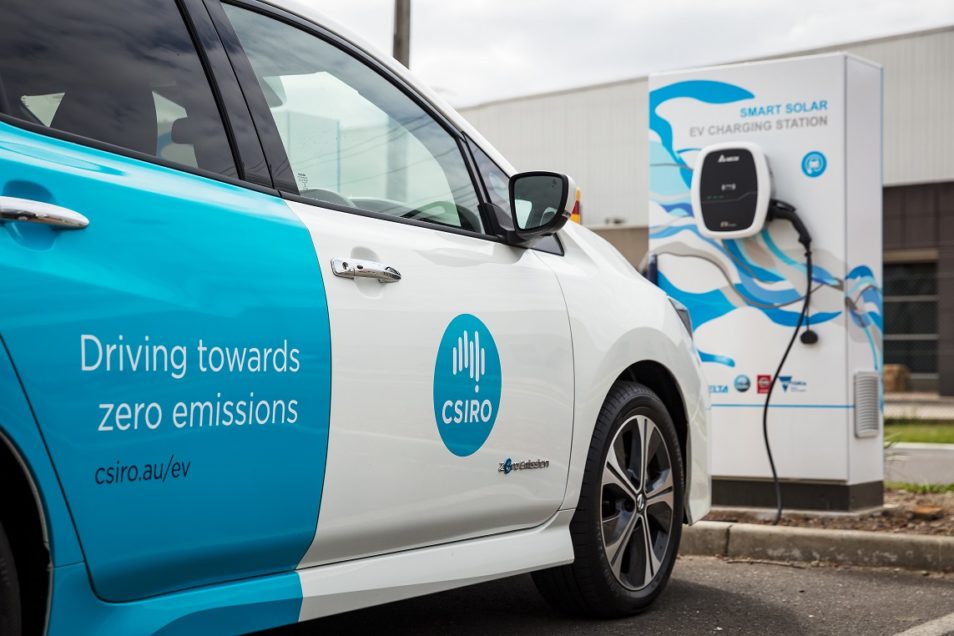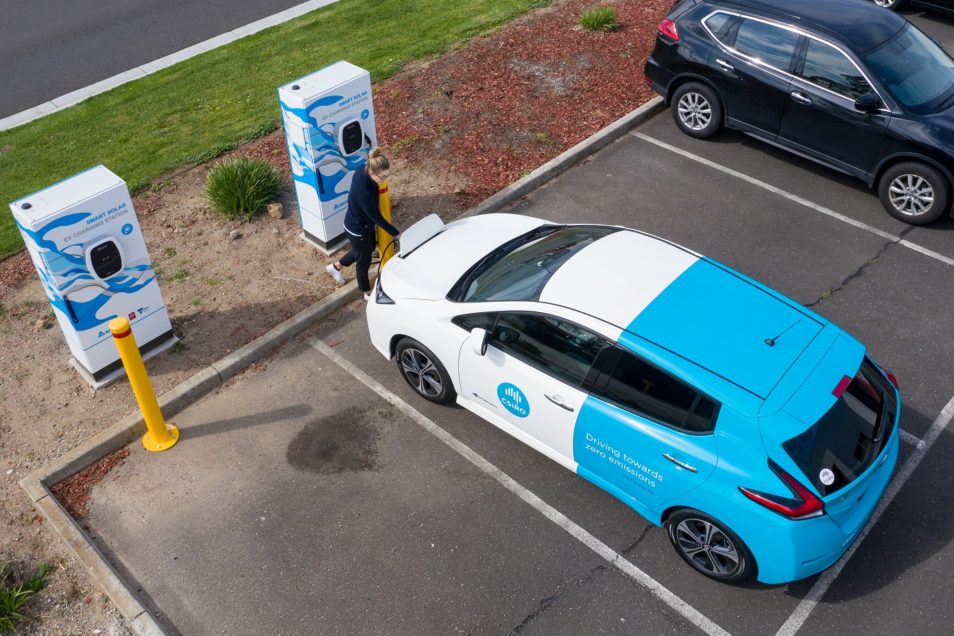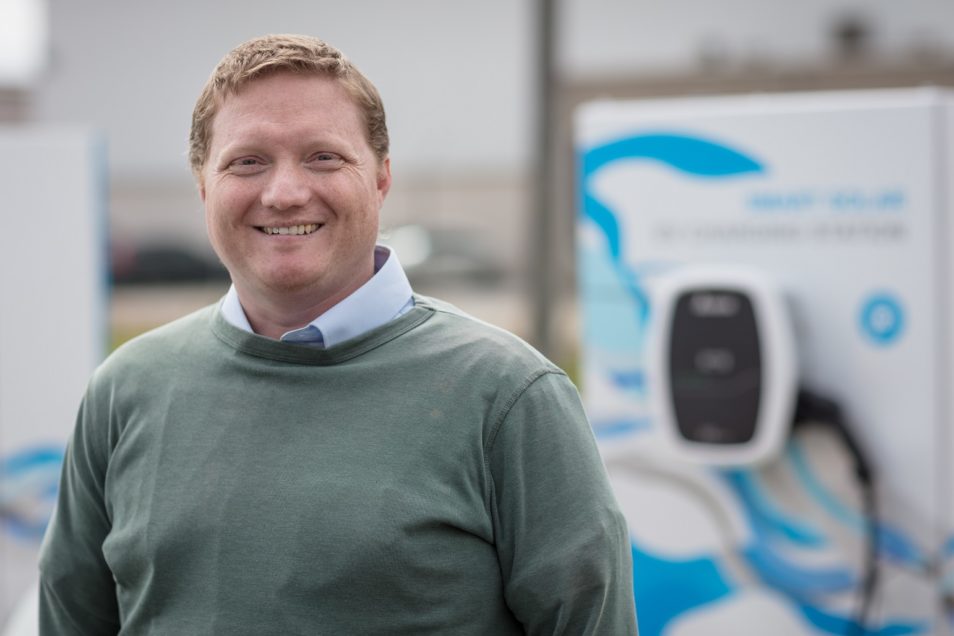
Solar panels on the building power the charging modules, which also contain a battery and our smart charging technology.
You’re cruising home after a long day at work. The orange fuel light starts blinking. It’s your car reminding you there’s only 20km left in the tank.
Traditionally, your next step would be to manoeuvre through peak hour traffic, sigh inwardly at the advertised fuel price, fill up and then be on your way… only to do it all again two weeks later. But with electric vehicles (EVs) gaining traction, this routine will change. Our new technology can help make this process even greener.
Electric vehicles plugging into solar
It’s new, it’s exciting. It’s solar-powered electric vehicle charging. This new system links your rooftop solar with a battery system and smart technology to manage the way your car is charged. Plus, it’s designed with the Australian household in mind.
There are many benefits to this system, which we’ll explain further below.
- You can power your car with home-grown renewable energy, which can also be stored for when it’s needed most.
- CSIRO-developed smart technology decides when to draw from solar, battery, or the electricity grid when your car is charging.
- You can reliably charge more than one electric vehicle at a time.
- Charging your electric vehicle in the height of summer is no sweat.

With renewable-powered charging technology, we really are driving towards zero emissions.
Clean, mean driving machine
Transport is Australia’s third-largest source of greenhouse gas emissions. And it’s increasing faster than in any other sector. Electric vehicles can make a huge impact here. They’re a cleaner option, even from using only grid power. But instead of using grid power, it makes sense we start using the power generated from Australia’s two million+ homes with solar photovoltaic panels.
You can store the solar energy you collect during the day in a household lithium-ion battery. This allows you to stash the energy away for later in the day when you plug your electric vehicle back in.
Our EV researcher Dr Christopher Munnings has done the maths and the argument for solar-powered charging stacks up. He said it’s a prime example of what’s called a ‘hybrid system.’ There we use multiple solutions (solar, battery, electric vehicle) for a positive result (lower emissions from transport). This is the type of research Chris performs in our Centre for Hybrid Energy Systems.
“Once you’re charging on renewables, the argument is pretty clear. An EV will emit less CO₂ over its lifetime than a regular internal combustion engine. If you recycle or reuse your batteries the numbers get even better,” Chris said.

It’s as easy as ‘point and shoot’, and overnight charging will become second nature.
Home is where the charge is
For most electric vehicle users, around 90 per cent of charging will be at home, meaning no peak hour detours to the servo. You’d likely go home as normal, plug the car in, and not think twice until you come back in the morning. Then your car will be charged and ready to roll – just like our mobile phones.
Australian city-dwellers drive an average of 30-40 km each day. Modern electric vehicles have a range over 250km. So, depending on your driving habits you may only need to charge an electric vehicle once or twice a week. After a while, it will become second nature to plug in daily.
What happens if we’re all charging our electric vehicles at once?
It’s possible the electricity grid could become stressed from the demand as more of us plug in our EVs each evening. This could be compounded during warm weather when the grid is under the most strain.
It’s also possible your household would want to charge more than one EV at a time with a standard grid connection. If this is the case, you’ll struggle to have enough spare power to run anything else. Like your air-conditioner, hairdryer and popcorn machine. You know, the essentials.
We’ve developed a new technology that controls when to charge your car, how quickly, and from which source (solar/battery/grid). It can also multi-task by charging up to four vehicles at a time. This is great for locations with limited grid connection, like at home, a shopping centre, or somewhere remote. This means a stress-free evening without having to reset fuses. It’s also great for the grid, which gets a smoother ride with no dramatic increases in power demand.

Our Senior Researcher Dr Christopher Munnings is plugged into all things ‘electric vehicles’.
Summertime solutions
Our electricity grid isn’t the only concern in warm weather. Often, battery systems can be less effective when the weather’s hot. When you need your car completely charged, this can quickly become an issue.
Our EV expert Chris said: “A normal household battery system is typically not powerful enough to charge a car on a hot day as it can overheat and slow down.”
“Our solar charging system can manage the temperature of the battery, minimising the amount of power required from the grid.”
“In a multi-EV home, this system will automatically monitor each car, spreading the load between the battery, solar PV and the rest of the home. This means the cars charge as quickly as possible, using as much sun as possible, without the need to upgrade grid connection.”
How do we know it works? We helped put the systems through their paces by installing three solar charging modules at Nissan Headquarters in Dandenong. Each module is capable of charging four vehicles at a time. They’ll be evaluated over 200 days, including the peak summer period. We look forward to reporting back and sharing what’s next for this exciting tech.
The project was funded by the Victorian Government and undertaken in collaboration with Delta Electronics and Nissan. Our researchers developed and tested the system and implemented the thermal management controls.


14th October 2019 at 10:17 am
They and other stations are not wheelchair accessible. I am a wheelchair (manual) wheelchair user am updating to an i3 travel mainly on my own so if plugs are not wheelchair accessible I am stuffed and have to go and try and find another station.
15th October 2019 at 2:33 pm
Hello Peter, the current project is just a trial before a permanent installation to identify technical issues as well as other problems. You are absolutely correct that many charging stations have not been setup to be wheelchair accessible and, in our view, this does need to be rectified so EVs are useable by everyone. One of the things we need to find from these trials are all these sorts of technical and user issues so they can be rectified before public installations are setup. For a wheelchair accessible charging station there are a number of things which need to be considered such as parking bay size (whether the doors can open fully), height of plug points, location of plug points (whether they can be reached by a wheelchair user or not), kerbs, for modified vehicles are there other considerations which need to be thought about, amongst many other thoughts. Clearly the current setup is not fit for purpose but the good news is that these stations are only temporarily installed and will be relocated at the end of the trial and we hope to have enough information to make recommendations to the installers by then. Thank you for commenting. Also I would like to invite you to contact us at csiroenquiries@csiro.au to help us understand the challenges and issues that you and other wheelchair users face while we do this next phase of development work. Obviously we need yours (and others’ input and experiences) so we can understand the problem better and then find a solution that can work.
Kind regards,
Kashmi
Team CSIRO
11th October 2019 at 7:45 pm
Should be commercial right about the time we’re likely to switch to an EV and upgrade the home solar system with a battery and extra panels… thanks CSIRO. You guys rock.
11th October 2019 at 3:19 pm
Hi
Wouldn’t it make more sense to have the panels at work and charge the car battery directly through the day rather than draining the house battery system overnight, the car battery could top up the house system if it has excess charge that isn’t required for your drive the next day
11th October 2019 at 10:44 am
How about solar panels in car roofs? It is not a new idea. In the 1940s “Ripley’s Believe it or not” quoted a Midwest librarian with an old electric car and old type photoelectric cells on its roof. She lived fairly close to work.
10th October 2019 at 6:23 pm
Until the problem of recycling lithium batteries is addressed you’re fooling yourself if you think electric vehicles are the answer
15th October 2019 at 2:32 pm
Hi Maxine, we asked one of our scientists about the current state of recycling lithium batteries, and they responded with:
“You are absolutely correct that some batteries have poor recycling rates. Currently in Australia, we have a good track record for recycling lead acid and nickel based systems but poor records for lithium batteries. There are a number of valuable materials inside lithium systems that can be reused for other industries and also for remanufacturing of lithium batteries. CSIRO has been looking at developing an Australian solution for lithium battery recycling where we can do the processing onshore and so not only solve the waste issue but also help out local industry. Seeing as this is not only an Australian problem but a Global issue, CSIRO has been developing deeper relationships with overseas researchers as well, such as the ReCell centre at Argonne National Laboratories in the USA, to see if we can pool our resources and find solutions quickly for everybody. It is theoretically possible to be able to recycle up to 95-97% of all materials inside a battery but currently this is not done industrially. CSIRO is looking at the technology development to see how much of this target we can achieve and still have an economically viable process that an industry can use. We are also actively looking at reusing the batteries before we dispose of them. If we take the example of a EV battery, when it reaches the end of life in the car, it can still do a few more years’ service as a household or grid battery shifting solar PV generation to evenings or mornings (as one example). By doing so, we can extend the lifetimes in service and push out when we need to send them to recycling. In light of the Circular Economy, this reuse option bis extremely important to make the battery technologies sustainability better. Finally we are also looking at developing technologies to make transportation of end-of-life batteries safe. Whether its at a collection point for small systems (e.g. car park or landfill collection drop off areas) or for large systems (at a recycling plant). We are also looking at seeing how we can maximise the safety of these systems when they are being disposed. When a battery reaches end-of-life, it still contains some ability to store energy. That energy should be removed to make the systems safe and this presents an opportunity to use that energy. CSIRO has been developing solutions to do this and also to capture the energy and feed into grids or buildings to help reduce electricity use. Our conservative calculations suggest that there could be up to 1000 to 4000 MWh per annum of electricity we maybe able to capture across Australia. Luckily for us, we still have a few years before the waste problem becomes critical. For most technologies (for example cars, household, grid) we probably have 5-10 years before the batteries being sold today need to be recycled. CSIRO is actively working on having research solutions in place and translated to industry by then for operation before we have a critical problem in Australia.”
Hope this helps.
Kind regards,
Kashmi
Team CSIRO